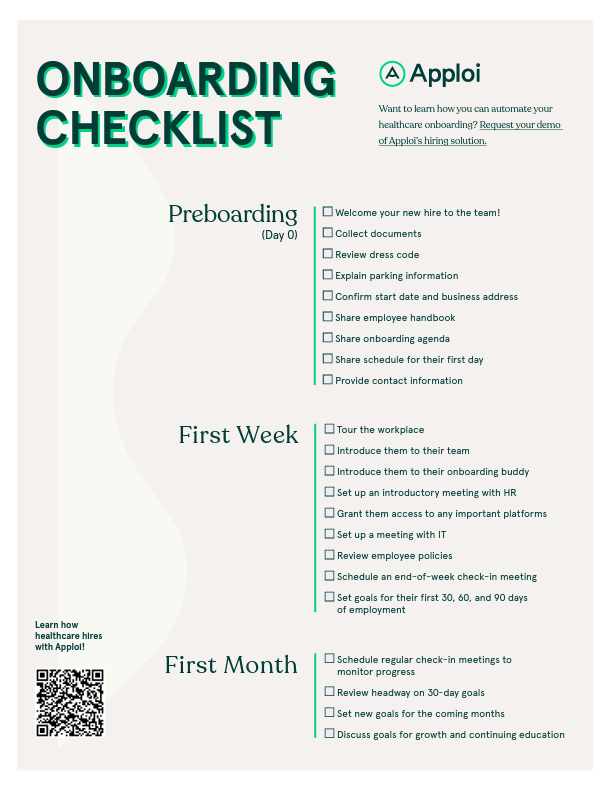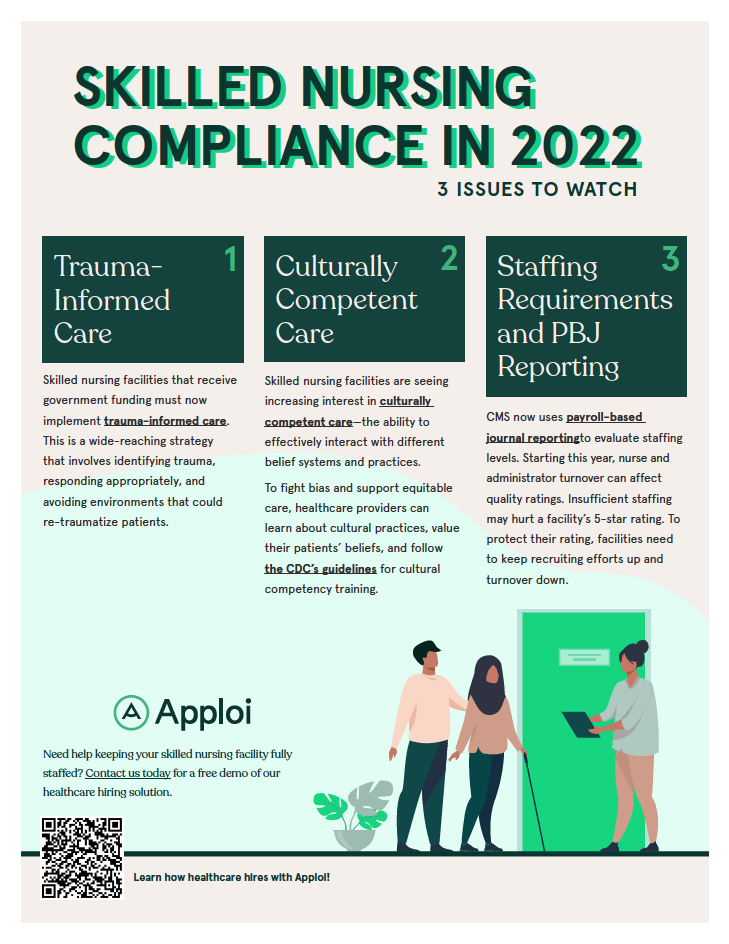
In This Series
- Staffing Guide for Skilled Nursing Facilities
- Seven Ways to Improve Your Skilled Nursing Orientation
- Nursing Home Hiring: Tips for Recruiting 7 Common Roles
- Healthcare Terminology for Skilled Nursing HR
- Skilled Nursing Retention: 10 Tips for Reducing Turnover
- Skilled Nursing Compliance Q&A with Healthcare Law Attorneys

FREE INTERACTIVE ONBOARDING CHECKLIST
Specifically designed for Skilled Nursing Facility Roles
STAFFING FOR SKILLED NURSING FACILITIES
In this guide, you’ll find tools to help you staff your skilled nursing facilities more efficiently, covering everything from recruiting through compliance. Browse the pages for downloadable assets like job description templates and comprehensive recruiting glossaries.

Tips for Recruiting Common Roles in Skilled Nursing Facilities
Skilled nursing facilities employ a wide range of clinical and non-clinical workers. Some hiring strategies (like automating workflows and building a social media following) will help you recruit practically any role.
But no two positions are entirely the same, and your recruiting strategy should reflect this. We explore some of the specifics of recruiting for individual roles.
Administrators
Traits like organization, attention to detail, and willingness to learn are arguably even more important than years of experience. You may find great administrator candidates by recruiting directly from educational programs.
Certified Nursing Assistants
CNAs are often undervalued and overworked. Because of this, a strong workplace culture can be a huge draw for these candidates. Stand out by offering career support, promoting internally, and training candidates in-house.
Cooks
Most professional cooks don’t come from skilled nursing facilities. You’ll likely be in competition with local restaurants, cafes, and catering businesses. Use these businesses to benchmark your compensation—not just other healthcare facilities.
Housekeepers
Housekeepers are employed by agencies, individuals, hotels, and more. To recruit effectively, highlight the benefits of working in skilled nursing facilities. This can include stable shifts, meaningful relationships with residents, and the chance to support an important mission.
Licensed Practical Nurses
Since LPNs work closely with RNs and physicians, they are strongly affected by your workplace culture. Encourage more applicants by publicly celebrating your existing team on social media, requesting candidate referrals, and, if possible, offering assistance with student loans.
Occupational Therapists
Occupational therapists are highly specialized, with lots of variation in their education and experience. Connect with the right candidates by using referrals, networking at professional events, and crafting tailored job posts.
Registered Nurses
RNs are in high demand, but they also experience relatively high levels of turnover. Use this to your advantage by reaching out to candidates who applied for roles in the last business quarter. It’s possible they’re now seeking a new role.

Skilled Nursing Glossary: HR Terminology to Know
Do you speak the language of skilled nursing facilities? Our free downloadable glossary will help you brush up your staffing vocabulary. It also makes a great welcome gift to new administrative workers who are entering the field for the first time.
If you find this resource helpful, we have even more glossaries to explore. Check out our free healthcare recruiting glossary, our guide of AI and automation terms, or our candidate experience dictionary.

Monitoring Compliance With Healthcare Law Attorney Terri Harris
If you receive funding from the Centers for Medicare & Medicaid Services (CMS), you need to stay abreast of compliance updates in order to maintain your funding. But regulations change routinely, and new requirements can be frustratingly imprecise.
FREE PRINTABLE INFOGRAPHIC
Top three CMS compliance issues to watch this year
To shed light on CMS compliance and recent regulatory changes, we connected with Terrill Harris, a specialist in health care law. In our conversation, we discuss some of the most pressing questions about how skilled nursing facilities can stay compliant.
Review our conversation to learn more about the biggest challenges to skilled nursing surveys, including implementing trauma-informed care, reducing COVID-19 infection rates, and the most important recent updates to CMS requirements.

How to Improve Your Skilled Nursing Orientation
Create a more efficient and effective onboarding process with these seven tips.
1. Use Digital Paperwork
Digital paperwork is typically quicker to complete and easier to protect than traditional paperwork. Send out a digital onboarding packet to engage new hires before their first day.
2. Tie in Your Mission and Culture
Healthy culture and a strong mission encourage applicants to accept a job—and to stay at your skilled nursing facility for longer periods of time. Use onboarding to contextualize your new hire’s role and demonstrate how they’re contributing to your facility.
3. Create a Library of Orientation Materials
There’s no reason to reinvent orientation every time you make a new hire. Store important files, employee handbooks, and orientation presentations in digital packets for easy access.
4. Comply Now, Save Money Later
CMS fined skilled nursing facilities 15 million dollars in 2020 for noncompliance. Get ahead by discussing compliance with your new employees and outlining their responsibilities.
5. Create a Mentorship System
Pairing new employees with mentors to ensure they have support in their early days of employment. A peer buddy system is another strong option.
6. Give Your New Hire Goals
Develop goals for your employees’ first 30, 60, and 90 days of work. Clear expectations can help workers feel confident about their contributions and assess their own performance.
7. Make All Training Materials Accessible After Orientation
Very few people can take in hours of information and remember it perfectly on the first try. Support your new workers by sending them their orientation materials to review as needed.

Retaining Workers in Skilled Nursing Facilities
Many healthcare roles struggle with high rates of turnover, but there are ways to improve your retention. Here are ten steps to take to help build a strong and lasting relationship with your current workers.
1. Build Flexibility Into Scheduling
About 80% of job seekers prefer professional opportunities that offer flexible shifts. In skilled nursing facilities, that could mean letting workers bid on shifts, swap shifts, or work unconventional hours.
2. Limit Shifts
Even if workers are voluntarily signing up for numerous long shifts, consistently demanding schedules can drive burnout and lead to turnover.
3. Mandate Time Off
Requiring workers to take time off is a controversial practice, but it’s the surest way to keep your employees rested.
4. Create Career Opportunities
Keep track of your workers’ career goals and use this information to inform your talent planning. Workers who feel they have a future in your company are more likely to stick around.
5. Engage Employees in Open Dialogue
Strong employee engagement actually improves patient care. Team meetings, career talks, and social events are all opportunities to drive engagement.
6. Recognize Employee Work
Feeling underappreciated is one of the most common reasons skilled nursing employees quit. Fight this by celebrating employees at team meetings, on social platforms, and one-on-one.
7. Designate Mentors
Mentorships can happen organically, but you can also assign enthusiastic mentors to new hires to help workers get situated.
8. Increase Workloads Slowly
Avoid overloading new workers. Instead, increase their duties over time, giving them time to get to know their workplace and colleagues.
9. Allocate Staff Correctly
Patient outcomes and employee satisfaction are both affected by the efficacy of your staffing allocation. Work on ensuring each shift includes the appropriate skill sets for patient acuity.
10. Update Your Systems
It’s frustrating to work with slow, clunky, and outdated systems. Keep your technology up-to-date to help your employees avoid needless friction in their daily work.
Interested in learning more about tackling healthcare recruiting, hiring, and onboarding from a single platform? Contact us today for your free demo of our human capital management solution.
In This Series
- Staffing Guide for Skilled Nursing Facilities
- Seven Ways to Improve Your Skilled Nursing Orientation
- Nursing Home Hiring: Tips for Recruiting 7 Common Roles
- Healthcare Terminology for Skilled Nursing HR
- Skilled Nursing Retention: 10 Tips for Reducing Turnover
- Skilled Nursing Compliance Q&A with Healthcare Law Attorneys
FREE PRINTABLE INFOGRAPHIC
Top three CMS compliance issues to watch this year

